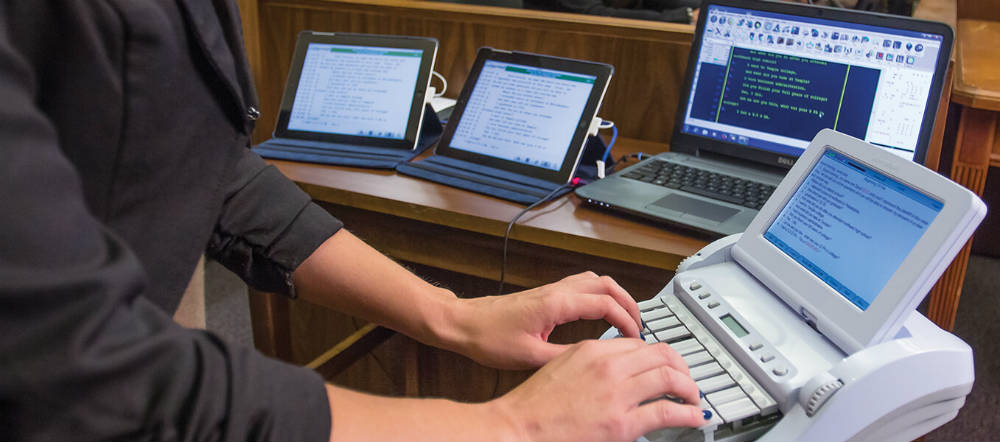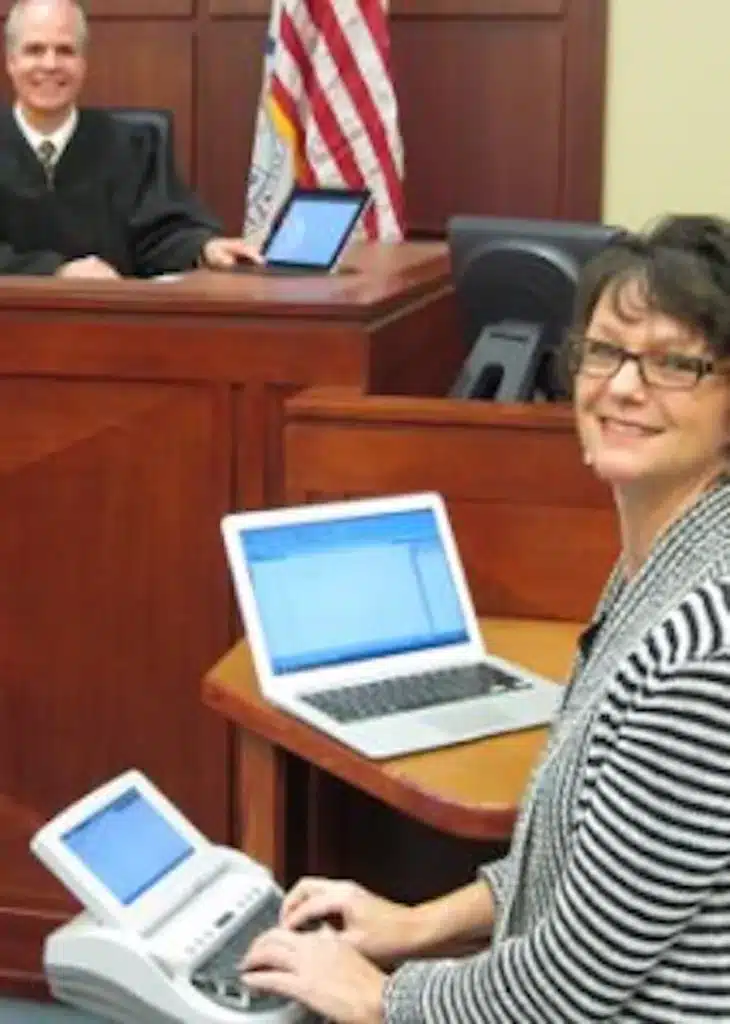Just How Court Reporting Functions: A Step-by-Step Overview to the Legal Process
Court reporting is a critical part of the lawful system. It includes an organized procedure that ensures accurate documentation of procedures. From preparation to the final distribution of records, each step is essential. Comprehending how stenotype reporter operate deals insight into the integrity of legal records. The subtleties of their job can exceptionally affect lawful outcomes, motivating questions about the methods and technologies they utilize. What are the particular methods that specify this career?
The Role of Court Reporters in the Legal System
Stenotype reporter play an important duty in the legal system by supplying trusted and accurate records of court procedures. Their work guarantees that every spoken word during hearings, depositions, and tests is recorded, which is essential for preserving a main record of events. This transcription is essential for charms, as it enables greater courts to review the procedures and figure out if any type of mistakes were made during the trial.
Furthermore, stenotype reporter assist in protecting the honesty of the lawful procedure by producing verbatim documents that can be described by legal representatives, judges, and various other events associated with a situation. They typically make use of specific tools and software to capture dialogue with precision. Beyond the court, their transcripts can work as crucial historical documents, supplying understanding into judicial procedures and the legal system's functioning. Ultimately, court press reporters add significantly to openness and liability in lawful issues.
Getting ready for a Court Reporting Session
Preparation is crucial for a successful court reporting session, as it assures the accuracy and effectiveness of the transcription process. Stenotype reporter start by examining situation products, consisting of pleadings and witness lists, to familiarize themselves with the terminology and context. They additionally make sure that they have the necessary devices, such as steno machines, note pads, and back-up devices, on-line.
Prior to the session, communication with lawful teams is crucial. Press reporters usually clarify any type of certain demands concerning formatting or favored terminology. Additionally, they may organize to meet attorneys or witnesses to talk about the process and confirm the schedule. Arriving early to establish the equipment permits troubleshooting potential technological issues. On the whole, comprehensive prep work not just improves the press reporter's self-confidence however likewise adds substantially to generating a clear and accurate record of the legal process.

Catching the Document: Techniques and Tools
Using sophisticated techniques and trusted devices, court reporters meticulously catch the spoken word during lawful proceedings. They employ stenography, an approach including a specialized machine that enables them to kind numerous sounds at the same time, consequently transcribing dialogue in real time. This equipment, referred to as a steno keyboard, is outfitted with secrets that represent syllables and words, making it possible for swift and accurate input.
In enhancement to stenography, stenotype reporter may utilize audio recording gadgets as extra devices. These devices act as back-ups, making sure that no important info is shed during process. Some press reporters include software that enhances their transcription effectiveness, providing attributes such as voice recognition and automated formatting.
Appropriate positioning and emphasis are vital; press reporters should maintain focus on all audio speakers, catching subtleties and inflections that add to the record. Via a mix of ability and technology, stenotype reporter copyright the stability of the lawful procedure by making certain a comprehensive and accurate document of occasions.
Transcribing the Process
Recording the procedures calls for stenotype reporter to convert spoken dialogue right into written message with remarkable accuracy and rate. This procedure commonly occurs immediately after the recording has been caught, using specialized software program that enables for smooth transcription. Stenotype reporter should listen diligently to the sound, guaranteeing that every word, time out, and inflection is accurately stood for in the transcript.
They typically rely upon shorthand systems, individual transcription abilities, and advanced innovation to facilitate this job. The atmosphere in which they function can be sometimes disorderly and hectic, as lawful proceedings commonly involve multiple audio speakers and technical jargon. Court reporters need to additionally preserve focus to catch nuances in tone and context that may be essential for the lawful record. Inevitably, the accuracy of the transcription is crucial, as it serves as a main record for future referral in lawful proceedings.
Examining and Modifying the Records
The process of evaluating and editing and enhancing the transcript is crucial for ensuring accuracy in court reporting. Court reporters frequently team up with lawyers to clear up any obscurities and validate the accuracy of the tape-recorded statements. This collaboration is essential for maintaining the stability of the legal document.
Importance of Precision
Precision acts as the cornerstone of effective court reporting, as even minor mistakes can greatly alter the significance of legal procedures. The assessing and editing and enhancing procedure is essential in guaranteeing that records mirror the spoken word with integrity. Bonuses Court reporters thoroughly verify names, technological terms, and lawful lingo to preserve accuracy. This interest to information helps avoid misconceptions that can impact instance outcomes. Additionally, precision cultivates trust fund among lawyers, customers, and the court, reinforcing the integrity of the judicial system. Errors can result in disputes or appeals, making it critical for reporters to improve their job completely. Ultimately, the pursuit of precision not just improves the dependability of the records yet also promotes the requirements of the lawful occupation.
Partnership With Attorneys
Cooperation between stenotype reporter and attorneys is vital throughout the examining and editing phase of records manufacturing. This process ensures that the final document accurately reflects the spoken word and sticks to lawful criteria. Attorneys usually evaluate transcripts for additional resources details terminology, context, and any possible mistakes that could influence the situation. Court reporters depend on attorneys' proficiency to make clear uncertain areas or emphasize critical declarations. Effective interaction is key; attorneys may supply comments or request modifications, which stenotype reporter need to deal with quickly. This partnership not only enhances the quality of the records however additionally contributes to a smoother legal procedure. Inevitably, collaborative efforts lead to a exact and dependable record, vital for legal proceedings and future referrals.
Providing the Last Records to Customers
Upon completion of the transcription process, stenotype reporter meticulously prepare the final file for delivery to their clients. This final records undergoes detailed proofreading to ensure accuracy, as any mistakes might significantly influence legal process. Court press reporters layout the document according to the particular needs stated by the customers or legal companies, including pagination, indexing, and any type of required exhibits.

Finally, court reporters might supply a cover letter summarizing key information and using further assistance if needed. This detailed approach warranties that clients get a refined, exact, and conveniently accessible transcript, important for their legal requirements.
Often Asked Inquiries
What Certifications Are Needed to Come To Be a Stenotype Reporter?
To come to be a court reporter, people usually require a senior high school diploma, conclusion of a court reporting program, and qualification or licensure, relying on state requirements. durham court reporting. Efficiency in shorthand and technology is also necessary for success
For how long Does It Require To Total Court Reporting Training?
Commonly, completing court reporting training takes between 18 months to 4 years, relying on the program's intensity, the trainee's rate, and the certain demands of the jurisdiction in which they desire to exercise.

What Is the Average Salary of a Stenotype Reporter?
The typical wage of a stenotype reporter varies by area and experience, generally ranging from $45,000 to $100,000 each year (durham court reporting). Variables such as field of expertise and demand can significantly influence their incomes in various regions
Are Court Reporters Required to Have Accreditation?
Court reporters are commonly required to acquire certification, which guarantees they have the necessary abilities and expertise for exact transcription. Certification requirements can vary by state or jurisdiction, mirroring specialist criteria within the legal community.
Can Court Reporters Work Remotely or Freelance?
Court press reporters can work from another location or freelance, offering versatility in their profession. Several utilize technology to record process from numerous places, permitting diverse chances in the legal field while maintaining a work-life equilibrium.
Court reporters play a crucial function in the legal system by giving dependable and precise transcripts of court process. Furthermore, court press reporters help in protecting the stability of the legal procedure by creating verbatim documents that can be referred to by lawyers, courts, and various other parties entailed in an instance. Using sophisticated techniques and trusted devices, court press reporters carefully capture the spoken word throughout legal proceedings. Court press reporters should also maintain concentration to record subtleties in tone and context that may be crucial for the legal pop over to this web-site record. To end up being a court press reporter, individuals commonly need a high college diploma, completion of a court reporting program, and qualification or licensure, depending on state needs.